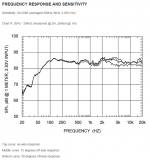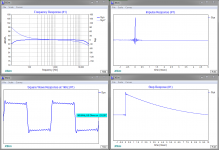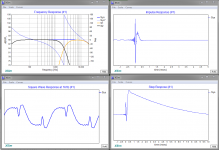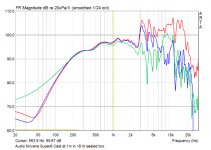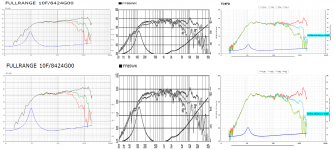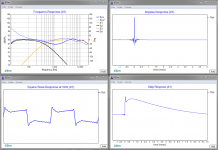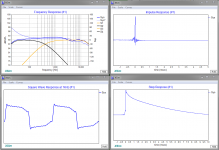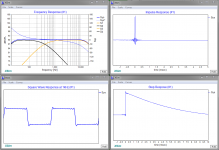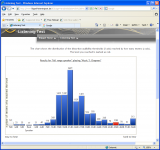Getting back to the question of the LS50, which like I imagine many of the posters here I've yet to hear, and not to contradict Colin's solid point re amplifier power, but ultimately I wonder if KEFs design target for the model in question - i.e. as a minimonitor in the same vein as the legendary LS3/5a- could be the constraining factor in meeting the OP's goals?
In all the noise that has transpired in this thread, has the question of size of the room / listening levels been discussed?
FWIW, count me in on the " no one size fits all" side of the ledger -
In all the noise that has transpired in this thread, has the question of size of the room / listening levels been discussed?
FWIW, count me in on the " no one size fits all" side of the ledger -
I can recommend listening to an active system such as the AVI ADM9 or DM10. It is slightly larger than the LS50 but capable of substantial headroom (it has 300 watts in each speaker). It will give the OP an idea of whether headroom is the problem. (Lower-power actives intended for home studios may not deliver the same results.)
Otherwise, as has been suggested, try the LS50 with a subwoofer system. If the sub blends in well, it will add depth to the sound and not just to the bass.
Otherwise, as has been suggested, try the LS50 with a subwoofer system. If the sub blends in well, it will add depth to the sound and not just to the bass.
Last edited:
OP if you enjoy your LS50 Kef's maybe try high passing them at 70-80 hz, and then adding subs from 70-80hz on down. Relieving the lows from your mains and adding some quality (read quality) low bass support can really open things up compared to what you're used too without breaking the bank.
cheers..
cheers..
sieniek,
Agree suggestions give LS50 a chance, inspiration could be if we look KEF's Blade model its Uni-Q driver looks physical the same plus woofer support.
Picture 1 is LS50 found this link SoundStageNetwork.com | SoundStage.com | NRC Measurements: KEF LS50 Loudspeakers.
Some visuals, in picture 2 you see one passband device 20-20kHz that is very good preserve waveform, in picture 3 you see same system passband 20-20kHz but blended from two passband devices with a LR4 XO at 2200Hz point as your LS50 have, XO adds a phaseturn that ruin waveform so it now is its own signature and not same as input.
Picture 2 performance is what one can dream of going full ranger but problem is get a driver to cover so much bandwidth is not down the road, a example is response seen in picture 4 which is a Audio Nirvana Super8 Cast Frame from this link Loudspeaker Raw Driver Measurements. HF reach and response is often a mess with big diameter full rangers and probably why first suggestions this thread pointed to less diameter full rangers with woofer support. In picture 5 datasheet from three small diameter full rangers is side by side stretched to same scale and in two X/Y ratios and as seen they better in HF area than 8" diameter.
A XO for small diameter full ranger X'ed to woofer will also add phase turn, arguments for that is alright is normal that the phase turn is below important 700-7000Hz mid area and then better compromise than traditional 2-way with XO point in middle that area.
Using DSP for speaker system XO/EQ/Offsetting can if it has FIR power too repair XO phase turn. So actual if you end visit Overkill Audio it should be possible he can dial in so LS50 gets flat phase as in picture 2 and add one of his subs so when dialed in to rooms mode will replicate fair close to picture 2 on design axis.
Agree suggestions give LS50 a chance, inspiration could be if we look KEF's Blade model its Uni-Q driver looks physical the same plus woofer support.
Picture 1 is LS50 found this link SoundStageNetwork.com | SoundStage.com | NRC Measurements: KEF LS50 Loudspeakers.
Some visuals, in picture 2 you see one passband device 20-20kHz that is very good preserve waveform, in picture 3 you see same system passband 20-20kHz but blended from two passband devices with a LR4 XO at 2200Hz point as your LS50 have, XO adds a phaseturn that ruin waveform so it now is its own signature and not same as input.
Picture 2 performance is what one can dream of going full ranger but problem is get a driver to cover so much bandwidth is not down the road, a example is response seen in picture 4 which is a Audio Nirvana Super8 Cast Frame from this link Loudspeaker Raw Driver Measurements. HF reach and response is often a mess with big diameter full rangers and probably why first suggestions this thread pointed to less diameter full rangers with woofer support. In picture 5 datasheet from three small diameter full rangers is side by side stretched to same scale and in two X/Y ratios and as seen they better in HF area than 8" diameter.
A XO for small diameter full ranger X'ed to woofer will also add phase turn, arguments for that is alright is normal that the phase turn is below important 700-7000Hz mid area and then better compromise than traditional 2-way with XO point in middle that area.
Using DSP for speaker system XO/EQ/Offsetting can if it has FIR power too repair XO phase turn. So actual if you end visit Overkill Audio it should be possible he can dial in so LS50 gets flat phase as in picture 2 and add one of his subs so when dialed in to rooms mode will replicate fair close to picture 2 on design axis.
Attachments
Last edited:
A XO for small diameter full ranger X'ed to woofer will also add phase turn
With careful choice of box a 1st order XO can be used and as long a drivers are within ¼ wl at the XO (ie drivers are effectively co-incident) there should be little to no phase issues.
dave
I don't quite see what the school yard shannanigans that Bob Brines is referring to other than P10 bashing the TC9 as is his usual practice on every available opportunity, syllable, letter, punctuation, or consonnant. -Yawn. Sad and tiresome but par for the course.
Well, if he thinks it is overrated and overexposed I can't really blame him for speaking out. Wouldn't you do the same? I haven't spent quality time with said driver so I'll keep out of the discussion for now. Valid negative criticism is just as important as positive surely though?
He would or could not have any bias or economic incentive to talk that particular driver down AFAICS.
Valid negative criticism is just as important as positive surely though?
Valid being the key word. All we ask is for substantiation by data of how FF85WKeN has more low level detail and how that data would show TC9FD being "lifeless" and how it loses all the low level detail from the music.
With careful choice of box a 1st order XO can be used and as long a drivers are within ¼ wl at the XO (ie drivers are effectively co-incident) there should be little to no phase issues.
dave
Good point.
Tumbled a lot with such setup it had some teasing points.
Don't sum as perfect as same filter in electrical domain seen in first XDir picture where ctc is set to zero to model filters electric circuit sum, setting real ctc distance as next four plots show adds tilted lobe and in that XO slope is so shallow that XO power profile is spread over relative wide band.
Slopes needs to be smooth deep over wide octaves but having XO point set low is problem because hard to measure exactly real response in real world room below 500Hz.
Picture 2 BW1 in perfect sum, picture 3 and 4 tweeter respectively 2 inches delayed or in advance show wide band errors.
On the other side DSP can XO in a hurry and repair ringing so XO area power response errors is less.
Attachments
Last edited:
Valid being the key word. All we ask is for substantiation by data of how FF85WKeN has more low level detail and how that data would show TC9FD being "lifeless" and how it loses all the low level detail from the music.
I really didn't want to say anymore, but if we have the pot calling the kettle black...
We have no test for (at least nothing accessible) for measuring low level detail so no graphs or measured data can be presented (by me, you or anyone).
And if we are asking for valid data where is yours? If we believe that the data you have presented is OK, you are making your declarations based on data that only includes the top 5 octaves. Is that valid?
dave
Valid being the key word. All we ask is for substantiation by data of how FF85WKeN has more low level detail and how that data would show TC9FD being "lifeless" and how it loses all the low level detail from the music.
As Dave says there is almost certainly ways of measuring the differences, just not with technology readily available to us.
Again look at the differences between the 10f and TC9. By adhering strictly to common measurements they should sound exactly the same. Yet they don't, and not by a small margin.
Dave's claim to valid critisism is our knowledge of his decades of experience and accomplishments. What used to be the real meaning of the word 'respect' (literally looking back) before it got distorted and watered down to the meaningless shell of a word it is today.
The 10F and TC9 may have similar frequency response shape. But that's where it ends. The measurements show it has much lower levels of HD. Perhaps one of the best 3.5in drivers ever. It also has a cleaner CSD and a tighter IR. All measurable. So to say those two drivers measure the same but sound different is not true. So don't keep pointing that out as an explanation because it's not.
As to availability or feasibility of measuring this so called low level detail. I don't think Planet10 has said that it can be measured ( if it's a real intrinsic property of a driver).
The ear hears frequency response shape as the dominant voicing feature. We are indeed beyond just the FR.
The ears hear harmonic distortion quite well. Despite Planet10 misquoting Gedlee on saying that "distortion measurements are meaningless". In the context of Gedlee's study of a small sample of college students who were asked to see if they could hear the differences in compression driver horns given various levels of HD while listening to the Talking Heads track ( distorted rock music to start). And like all good scientific studies he had a control group? No.
Very good scientific double blind test of HD was developed by Klippel. You should take it. Everyone should know where their HD tolerance baseline is. Mine is -45dB listening to Tracy Chapman on headphones.
I am not taking the decades of experience that P10 has away from him. But if his experience provides guidance of design choice based on unfounded or unproven or unmeasurable quantities of a certain driver while denegrating another driver without data to back it up - then that isn't right.
As to availability or feasibility of measuring this so called low level detail. I don't think Planet10 has said that it can be measured ( if it's a real intrinsic property of a driver).
The ear hears frequency response shape as the dominant voicing feature. We are indeed beyond just the FR.
The ears hear harmonic distortion quite well. Despite Planet10 misquoting Gedlee on saying that "distortion measurements are meaningless". In the context of Gedlee's study of a small sample of college students who were asked to see if they could hear the differences in compression driver horns given various levels of HD while listening to the Talking Heads track ( distorted rock music to start). And like all good scientific studies he had a control group? No.
Very good scientific double blind test of HD was developed by Klippel. You should take it. Everyone should know where their HD tolerance baseline is. Mine is -45dB listening to Tracy Chapman on headphones.
I am not taking the decades of experience that P10 has away from him. But if his experience provides guidance of design choice based on unfounded or unproven or unmeasurable quantities of a certain driver while denegrating another driver without data to back it up - then that isn't right.
Attachments
Last edited:
Drivers can be compared to martial arts sometimes. They have there differences but condemning one usually isn't fair without really speanding time with it. After spending time you can determine if one style or another is worthwhile. I can certainly understand why one would feel the Vifa is lifeless when compared to a Fostex after being accustomed to the Fostex. But I also feel the opposite could be the case.
In my experience both brands are very capable regardless of their distinct sonic signatures. Certainly the Fostex is more colored but wonderful nonetheless. The Vifa strives for accuracy at the expense of treble. Some like Judo while others prefer Boxing. The one that wins the day depends on who can apply their techniques in a given situation.
Both brands appear equally well made tho it would not surprise me to learn the less expensive driver costs more to make than the more expensive one.
I'd like to learn both Judo and Boxing. Certainly, I respect both styles.
In my experience both brands are very capable regardless of their distinct sonic signatures. Certainly the Fostex is more colored but wonderful nonetheless. The Vifa strives for accuracy at the expense of treble. Some like Judo while others prefer Boxing. The one that wins the day depends on who can apply their techniques in a given situation.
Both brands appear equally well made tho it would not surprise me to learn the less expensive driver costs more to make than the more expensive one.
I'd like to learn both Judo and Boxing. Certainly, I respect both styles.
The 10F and TC9 may have similar frequency response shape. But that's where it ends. The measurements show it has much lower levels of HD. Perhaps one of the best 3.5in drivers ever. It also has a cleaner CSD and a tighter IR. All measurable. So to say those two drivers measure the same but sound different is not true. So don't keep pointing that out as an explanation because it's not.
As to availability or feasibility of measuring this so called low level detail. I don't think Planet10 has said that it can be measured ( if it's a real intrinsic property of a driver).
The ear hears frequency response shape as the dominant voicing feature. We are indeed beyond just the FR.
The ears hear harmonic distortion quite well. Despite Planet10 misquoting Gedlee on saying that "distortion measurements are meaningless". In the context of Gedlee's study of a small sample of college students who were asked to see if they could hear the differences in compression driver horns given various levels of HD while listening to the Talking Heads track ( distorted rock music to start). And like all good scientific studies he had a control group? No.
Very good scientific double blind test of HD was developed by Klippel. You should take it. Everyone should know where their HD tolerance baseline is. Mine is -45dB listening to Tracy Chapman on headphones.
I am not taking the decades of experience that P10 has away from him. But if his experience provides guidance of design choice based on unfounded or unproven or unmeasurable quantities of a certain driver while denegrating another driver without data to back it up - then that isn't right.
The 10f's different parameters you mention could strictly be attributed to the differences in Q values. Total Qts of the 10f is quite low for a driver of it's type.
IR seemed about the same though as I recall? The 10f will not go as low and will require another type of cab to have equal footing in the lower octaves. AFAIR you had them both in a OB?
The ear hears frequency response shape as the dominant voicing feature. We are indeed beyond just the FR.
I don't understand what frequency response shape means here?
There are other studies than Geddes, that show that HD was not as important as previously implied by he hysteria/penile measurement phenomenon manufactures spec sheets would have us believe.
I don't have the time to dig them out right now, but I'll see what I can do later.
HD is of course important to some degree. It seems just not the main pillar of good reproduction it was made up to be.
Right now it's just your word against his. We won't have measurements to say anything conclusively soon. Question is, do you accept that there are things of importance that we are not currently able to measure with the usual setup?
>>> Question is, do you accept that there are things of importance that we are not currently able to measure with the usual setup?
I know this question isn't addressed to me but I remember several years ago when back horn design was considered to be a bit like magic until the BIB calculators came out.
I also think it's worthwhile to consider immeasurable qualities to possibly be listener preference without any way to quantify.
I was a magician many years ago. I performed at children's parties. I love magic and wanted to believe. I don't believe in magic.
I wanted to believe in Chi too. But after 17 years and three different styles of martial arts I gave up on that too.
I know this question isn't addressed to me but I remember several years ago when back horn design was considered to be a bit like magic until the BIB calculators came out.
I also think it's worthwhile to consider immeasurable qualities to possibly be listener preference without any way to quantify.
I was a magician many years ago. I performed at children's parties. I love magic and wanted to believe. I don't believe in magic.
I wanted to believe in Chi too. But after 17 years and three different styles of martial arts I gave up on that too.
I will buy a pair of FF85WKeN
Planet10:
I have a proposal to make. I will personally buy a pair of Enabled FF85WKeN from you, assuming you have some in stock or can make them, and judge for myself how it sounds in a FAST. I have heard nothing but praises for this driver and want to see what it's all about. If not available immediately, it's not a big rush. I will send you PM.
Who knows, maybe I will have a new favorite driver for the reference monitor 10F/8424 RS225 FAST?
Right now it's just your word against his. We won't have measurements to say anything conclusively soon.
Planet10:
I have a proposal to make. I will personally buy a pair of Enabled FF85WKeN from you, assuming you have some in stock or can make them, and judge for myself how it sounds in a FAST. I have heard nothing but praises for this driver and want to see what it's all about. If not available immediately, it's not a big rush. I will send you PM.
Who knows, maybe I will have a new favorite driver for the reference monitor 10F/8424 RS225 FAST?
I am just currently starting another batch. Probably about 3 weeks or so till they are done. 1 pr off to Greece and i have to set aside a stock pr (too many asking for compares of stock instead of treated to not). The rest are unspoken for as of yet.
eMail me.
dave
eMail me.
dave
Now, about this question of Chi ...
This could be considered Chi, or maybe he's just nuts! 😀
https://www.youtube.com/watch?v=oTIW5KtUUxY
- Status
- Not open for further replies.
- Home
- Loudspeakers
- Full Range
- Full Range speaker project
